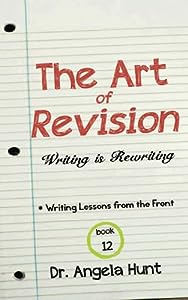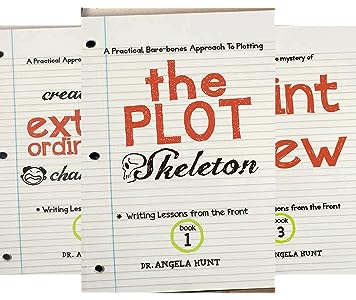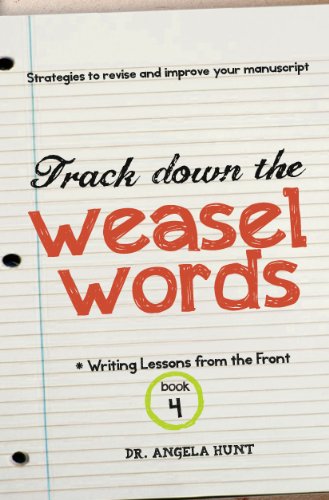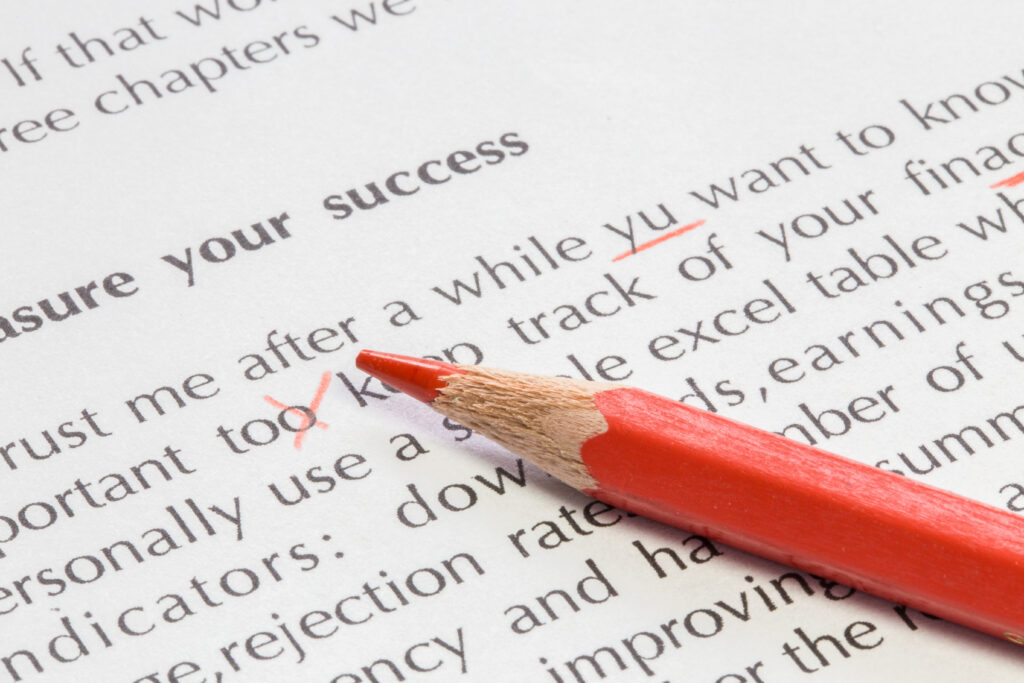No one produces a perfectly polished novel in one draft. Everyone starts out writing rough first drafts, but the ability to revise those drafts is what separates successful authors from struggling authors.
Every author knows that good writing requires rewriting, but there is a big difference between making changes and making improvements. Rewriting only improves your rough draft if you know what to look for.
The term “revision” means “to look at again.” So, how do you know what to look for? How do you know what needs to be rewritten, revised, reworked, or even rejected?
Angela Hunt has mastered the art of revision. She’s the author of 165 books in various genres and has sold over 5,000,000 copies worldwide. It’s safe to say Angela has transformed hundreds of manuscripts into masterpieces through her revision process.
Did I write a masterpiece or a monstrosity?
Thomas: When we finish a manuscript, we initially feel like it’s a masterpiece. But after we sleep on it, give it a few weeks, and start the edit, we start to believe there’s nothing salvageable in that draft.
But neither extreme evaluation is accurate.
Angela: At this point in my career, I never think that my first draft is a masterpiece. Never. In fact, it usually seems like gobbledygook; but at least with one draft written, I have something to work with.
I don’t really know what my story’s about until I’ve finished a first draft. After I finish the first draft, I’ll have a vague idea about where my story is going.
In writing, the more you know, the more you know you don’t know; and the worse your manuscript seems. Regardless, I’m always grateful to have completed the draft so that I can start operating on it.
How do you keep from getting discouraged?
Thomas: Many authors finish their manuscript, realize it’s not a masterpiece, and start to feel hopeless. They wonder if they should give up on being a writer.
What do you do when you see a bunch of problems in your manuscript?
Angela: If you’ve finished a first draft, pat yourself on the back. Many people say, “I’ve always wanted to write a book,” but few of them do. If you complete a first draft, you deserve congratulations because that’s hard.
I always use the analogy of birthing a baby, which I’ve never done; but I hear it’s hard work. Women huff and puff, sweat and cry, and groan and moan; but when they’re done, they have a baby. It’s messy. But the baby is born, and that is cause for celebration.
Don’t be discouraged when you look at your pile of words on the computer or paper. You have accomplished what most people only talk about. You have created a first draft. There’s always tomorrow to start revising to make it something you can be pleased with.

Angela Hunt’s Five Steps of Revision
Angela: I go through a five-draft process. Sometimes it’s six drafts, depending on how much work needs to be done.
Step 1: Create the Rough Draft
Rough drafts are tough. I’m writing one now; and when my husband asked how it was going, I answered, “I don’t know what I’m doing. I just fling words onto the computer and hope I’m going in the right direction.”
It’s that bad, and I’m a plotter!
Thomas: You’re a plotter who’s written 150 books and sold 5,000,000 copies, so are you saying it doesn’t get better?
Angela: No. It gets harder! The bigger your vision for a book, the harder it is to encapsulate.
My goal for the first draft is to get the story down on paper. Once it’s created, I can clean it up and work with it. My number-one mantra in the first draft is “Do not stop.” You get momentum in your writing zone. I don’t break my momentum to look something up. That is for the second draft.
Instead, when I’m writing my first draft, I’ll write, “She went down [find the name of the street she would have gone down] street,” and I keep writing. I might write, “He took her to the temple of [figure out what temple was at this location].”
Step 2: Filling in the Blanks
Draft two is about filling in the gaps and blanks.
As I’m writing the first draft, ideas will occur to me; but I never stop writing during the first draft. I never go back to edit or fill in anything.
I write in Scrivener. On the right side of the screen, there’s a lovely place where you can jot notes. If I think of a detail I need to add to my story in the second draft, I will make a note of it on the side of my screen.
I might make a note that says, “Incorporate a spiritual element here,” and I will do that on my second draft.
My second draft is all about filling in the gaps, deepening the story, adding characters I’ve discovered, deleting redundant characters, or combining characters.
Readers get daunted if you use too many character names for them to remember at once.
Draft two is still very writing oriented. The editorial part of your brain is different from the creative part, so I stick to using one part at a time. In the first two drafts, I concentrate on writing.
I can finish a 100,000-word book in five months, which allows me one month for each draft. I never work on Saturdays, and I rarely work on Sundays. That means I’m writing five days a week.
Thomas: You’re writing 100,000 words in one month by focusing on writing instead of writing and editing at the same time. You simply don’t go back and edit while you’re in writing mode. Many people think that’s impossible, but you’ve done it dozens of times.
People who have been working on their books for years are constantly going back to fiddle with things, and it’s unproductive.
Angela’s process is productive and reproducible. I’ve noticed that prolific authors have a regimented process. They know what they’re doing in each draft, and they know what to worry about later.
You’re not messing with commas or passive voice in the second draft. You’re just adding things that you forgot the first time.
Angela: My first draft will only be about 50,000 words. It’s bare bones. I am slapping that stuff into the computer off the top of my head. I don’t stop to research.
However, before I start writing, I do about a week of big-picture research.
For instance, my current book is set in ancient Rome. I’ve written several books set in that period, but not in the city of Rome itself. I’ve been focusing on the great fire of Rome, which happened in AD 64; and I’ve had to resist the temptation to make the book about the fire. It’s such an important event; but in my story, it’s just the inciting incident.
In the second draft, I’ll search my document for the brackets I inserted in the first draft; and then I’ll fill in those gaps. During the second draft, I’m still in creative mode and continue to flesh out the story.
By the time the second draft is done, I’ll have added words. If my first draft was 50,000 words, the second draft may well be 65,000. But I’m still not done, and I’m still not sweating it. I still don’t think it’s irredeemable. I know it’s a whole lot better, and I’m making progress.
Thomas: Stephen King very famously believes that the second draft should equal the first draft minus 10%. But in your method, the second draft is the first draft plus 15%, roughly, because you’re adding details in that second draft process.
Those brackets can save you a lot of time because once you get into Google research mode or get lost in Wikipedia, you may not return to the writing world that day.
Angela: When you start your research, you don’t know what details you’ll need. Some fiction writers make details up, but I don’t dare do that because there are so many Roman experts out there. I am going to take the time to get those details right. But I didn’t know which details I would need when I was in my research mode.
The second draft has all the bones of the plot skeleton, and I review it to see if anything is missing.

Sometimes when I hit a wall and the story’s just not hanging together, I’ll discover there’s a bone missing. Maybe there’s an element in the plot that’s completely missing, or perhaps I named the wrong event the wrong thing. This is where I go back and make those adjustments.
Between each draft, I take at least two days for what I call “triage.” Sol Stein says that in medical triage, you fix what’s bleeding or whatever is most urgent. The same applies here. I search the draft I’ve just finished for the glaring mistakes I need to fix before I go forward.
Step 3: Begin Editing
After I make sure all the plot elements are present and doing their jobs, I shift into editorial gear.
I begin by using the “find and replace” feature to search for my weasel words which we have discussed in another episode and which I have ignored for the first two drafts.
In the first two drafts, I write in the way I talk, and the words spill out.
For the third draft, I search for every occurrence of “was” with a space on each side of it ( was ), then I replace it with capital WAS. With a few clicks, every occurrence is marked throughout my manuscript. I do the same thing for other words:
- Were
- Smiled
- Nodded
- Just
- Suddenly
I have a whole list of weasel words, which I list in my book Track Down the Weasel Words. Everybody has their own set of weasel words. For example, I’m really fond of eyebrows, so I’m always having brows lifting and arching and curling and furrowing. If you use those things too much, they become noticeable and distracting.

I also check my points of view. But during this third draft, I’m mostly weighing every sentence to make sure it says exactly what I want. I make sure I know the meaning of the words I’ve used.
I’ll also look for adverbs. We should not use adverbs in speaker attributions. You never want to write, “he said sarcastically.” The sarcasm should be in the words, not in the adverb. If you merely use an adverb to describe how he said it, you’re telling the reader how he spoke instead of showing it.
To find adverbs in attributions, I will search for “ly” and replace each instance with capital letters and a period (LY.) so I can delete those adverbs.
After I’ve done all that, I read through my manuscript again from the beginning. If I think of a better way to say something, I revise. The writer part of my brain is not shut down. But at the same time, the editorial part of my brain is alive and thinking critically, weighing every word.
For example, with was and were marked throughout my manuscript, I examine each instance. Instead of saying, “He was standing by the door,” I’ll rewrite it to say, “He stood by the door.” It’s much more active.
Every time I see one of those words, I try to replace it with an active verb instead of the passive was or were.
Thomas: Are you still making plot changes, or is the plot settled at this point?
Angela: The plot is more or less settled. In this draft, I’m starting to deepen the spiritual theme. Christian novels need to have an element of Christ or a faith thread. I’ve hinted at that theme in previous drafts, and I’ve included the events that will lead to it; but it’s not there yet. I usually weave in the spiritual theme and deepen it while I’m doing the third draft.
In this third draft, I still end up adding words; but they’re stronger words, and they’re words that deepen the character and the spiritual thread of the story.
Thomas: This is what good revision looks like. You’re taking out weasel words and using your budget of cut words to add spiritual and emotional substance. As a result, the story is more powerful.
Angela: In the third draft, I also add “mood music.”
When you watch a movie, you hear the music rise and swell, so you lean forward because you know something dramatic is going to happen.
Well, you can do the same thing in your novel or even in nonfiction by adding some mood music.

If I’m writing a spooky scene, I will create the equivalent of “It was a dark and stormy night.” I won’t be that trite because Snoopy took that line already. But I will add “the howl of the wind,” “the scrape of a tree branch against the window,” or something else to paint that scene in darker colors.
I’ll take the scene I’ve already written twice and color it with words that set the scene musically. Now, it still has to be written from the point of view of one person, so my heroine or hero will hear the wind howling or see the birds flapping off in the distance.
When an artist creates, they start with a sketch on a canvas. Then they rough it out with paint. On the third pass, so to speak, they start to add the background and the colors and make that canvas come to life.
I’m doing the same thing in the third draft with words. I’m adding things that will deepen the canvas colors, so to speak. We’re fleshing out that scene by adding sights, sounds, textures, tastes, smells, or intuitions. I always try to represent at least three senses in every scene.
Using sensory details causes readers to say, “I felt like I was right there as I was reading.” I try to make them feel like they’re in that room, hearing, seeing, and smelling what my character is.
Thomas: Your first draft goes faster if you know you’ll come back later and add the sensory details to the scene. You can get the core elements of the scene and the most obvious scents as you’re drafting the first time, but you don’t have to agonize over it and slow down because you know you’ll deal with the sensory details later.
By giving each task its own little slot in this process, you can work faster and still have a better product in the end.
Step 4: Listen to the Manuscript
Angela: I begin draft four by searching for my weasel words again because they sneak back in when I add details and fill in gaps. I’m constantly checking and rechecking new material I’ve added.
The chief task in draft four is to listen to the manuscript with my ears.
It’s different than reading aloud. I’ve discovered that when I’m writing, I type quickly; and I tend to skip a lot of little or important words. If I’m reading it myself, my eyes just skim over the text, and I miss them when I’m proofreading. I’m a horrible proofreader.
So, I print out a copy of the manuscript; and then I have the computer read it to me.
Now this is important for a couple of reasons. When readers read your book, they hear the words in their heads. That’s how the brain interprets it. Therefore, if you hear your book read to you, you’re going to be as close as possible to what your reader will experience.
When I listen, I hear repeated words, missing words, and repeated sounds, such as “She stared at him as he went down the stairs.” That sounds horrible. It clanks against your ears. Sometimes the same sound in two words used closely together will sound bad.
As I’m reading along on the printed manuscript, I mark the words that are clunking against my ears.
I work through the manuscript scene by scene. After I listen to a scene, I go back and revise everything I marked; and then I listen to it again. I work through the entire book that way, cutting and adding words.
Thomas: The practice of listening to your book is becoming far more important than it was 15 years ago. The fastest-growing segment of book buying right now is audiobooks. Audiobooks are exploding. In some years, ebook sales are flat or down for traditionally published books. But we have not had years where audiobook sales are down. They are growing, often by double digits, year over year.
Audiobooks have become a major part of the market, so it’s super important to know how your book will sound when read by a professional narrator. Even though the professional narrator has a beautiful voice, it still doesn’t sound good to say, “He stared at her while she walked down the stairs.”
The original form of reading books was to listen to them being read aloud. Silent reading wasn’t invented until around 300 AD when the first monks started figuring out they could read silently.
Angela: I released a book last week, and I was amazed to see that the audiobook was easily outselling the Kindle ebook and the paperback on Amazon, which I thought was very interesting.
We’ve been discussing this on my Facebook page, and people say, “I love audiobooks because I can do two things at once. I can listen while I’m cleaning the house or washing dishes.”
People love audiobooks because it helps them feel more productive.
When you listen to the computer’s robotic voice, as opposed to a professional narrator, it’s easier to tell if the emotion is conveyed through the words. If it’s not, you need to rewrite those words or that dialogue.
A lot of times, when we read it in our heads, we’re supplying the emotion because we want it to be there. But you’re not around when your reader is reading or listening, so you must use words that convey that emotion to the reader.
I am at the point now where I would not hand a book in unless I’ve listened to it.
Thomas: I love the picture of an author sitting with her back to the computer with a piece of paper and a pen. In some ways, it’s a high-tech editing technique because AI is reading the text. But in other ways, it’s low-tech because you’re there with an ink pen and actual dead trees in your lap, marking what needs to be fixed.

You don’t need special software to have your computer read your manuscript. Your Windows computer or your Mac is perfectly capable of reading. It will be a robotic, ugly-sounding voice; but in this situation, that’s a feature, not a bug. If that robotic voice can convey the emotion of your book, then your narrator will be able to convey the emotion as well.
Step 5: Polishing the Draft
Angela: In the fifth draft, I try to catch all the things that will make my manuscript look like an expert writer handed it in. I look for correct punctuation and make sure it’s formatted correctly.
Those are the details that cause editors to say, “Oh my goodness! She knows how to use an ellipsis.”
I typically set aside three or four days to go through the entire book. I will have the computer read it to me again, but this time we’ll do 50 pages per day rather than one scene at a time.
Right before I hand it in, I print out a copy that’s been properly formatted in Vellum, which I highly recommend because it will make your book look professional in a heartbeat.
I print that formatted copy because I’ve discovered that my eye picks up mistakes in a formatted copy that it missed in a manuscript copy. When you read your words as a book, your eyes and brain shift into a different mode.
When do editors and beta readers get involved?
Thomas: You’ve done five drafts, but you haven’t brought in a professional editor or beta readers. Now you have a polished draft, but it’s still not finished yet. Who do you give this polished manuscript to?
Angela: I had a friend who worked for a Christian bookstore. She read tons of books and knew what the market would bear. I used to send my manuscripts to her, and she would give me honest feedback.
She did not mince words. If there was something she thought the Christian market would dislike, she would let me know.
Writing is an exercise for someone else. It’s for your reader. You’re offering your work to benefit a reader, so you must keep the reader’s sensitivities in mind.
She has since passed away, so now I ask my Facebook page followers. I’ll post an announcement saying, “I need five readers to read this unpublished, unedited manuscript, and I’ll send it to the first five people who respond.”
By the time I come back to Facebook after lunch, I usually have ten volunteers. I then publish my book in Vellum and send it to those volunteers. I never harass, harangue, or even follow up with them. If I don’t hear a response, I figure they were too busy to read it, and that’s fine.
But when I hear back from those readers, I seriously consider the things they had to say. If necessary, I make changes based on their feedback.
Be careful when you’re looking for beta readers. If I get too many opinions, I get confused, so I never send the manuscript to more than ten people. Three to five beta readers are probably sufficient.
My Facebook followers are usually Christians who read my books, so they know me and my writing. They know the market and have always given me great input. If I disagree with their feedback, that’s my prerogative. But they have been right about a lot of things, and I value their input.
When does the publisher’s editor get a crack at the text?
Angela: After I implement the necessary changes, my editor takes about a month to read through it. Then she’ll send me an editorial letter with things that she and other editors at the publisher thought were good.
They tell me what could be changed, deepened, or improved; and those suggestions are always regarding big-picture things.
After I make the changes suggested in the editorial letter, then the manuscript goes to a line editor and a proofreader. We’ll read and proof galleys at least two or three times.
By the time the book goes to print, I am thoroughly sick of it and ready to move on to something else.
Thomas: That first professional edit that arrives in the form of a letter is called a developmental edit. Unfortunately, many indie authors skip that edit because they often don’t know they need one.
Some copy editors will go after weasel words and help you pull those out, but that developmental edit looks at the story. A developmental editor might say, “This character needs to be more likable,” or “The way they were speaking to this other character may cause the reader to stop liking your protagonist.”
That kind of feedback is important, and you need that feedback before you get the copy edit. You don’t want to waste time and money on a copy edit of a chapter that needs to be deleted or changed.
Sometimes you’ll need to change a lot and other times, only a little. You may disagree with your developmental editor, but it’s important to know whether you disagree about the problem or the proposed solution. The editor just wants the problem solved, and you might have a better way to solve the problem than the editor suggested.
But if you disagree about whether there is a problem, you need to be able to defend yourself. You need to understand the writing craft well enough to articulate why you believe it isn’t a problem.
Angela: Some people call it the overall edit, a substantive edit, the macro versus the micro edit; but whatever you call it, it’s the most important one. It will make or break your book.
Most authors feel an initial sense of dread when they get that letter because they handed in the manuscript, thinking it was as close to perfect as it could be.
I’ve written 165 books, and twice I have had editors write me back and say, “This is not working for us. We cannot publish this the way it is.” Those are the letters that make you want to sit in a dark room for a few hours. But in both instances, they were right. That is why they’re editors.
On the first occasion, I used the bones of the plot but rewrote the whole surrounding story. The second time, I put it in a drawer and wrote an entirely different story because I had a deadline and needed to get to work.
Your best friend who majored in English in college or your wife or your mother-in-law may know where the commas go, but a developmental edit requires an expert in story. The developmental editor can recognize where your plot is and isn’t working or whether your antagonist has taken over your story.
Unfortunately, most young writers are resistant to this advice. But if you want your book to have a chance at success, then you really need to heed that advice.
Thomas: Even Angela Hunt, a Christy-award-winning, bestselling author with millions of copies sold, has turned in books that the editors don’t want. That is important to know. If you’re rejected by your publisher, or they pass on your manuscript, it doesn’t mean your career is doomed. It doesn’t mean you’re a bad author.
Even Michael Jordan had bad days on the court.
Revising and rewriting are part of your work. We don’t live in the Garden of Eden anymore. There are thorns and thistles and weasel words that climb into your perfectly good prose and make the work hard.
We do the work. We glorify God through our work. We take out the thorns and thistles and weasel words. And if you’re diligent and faithful to do the work, you will reap what you sow.
Through this arduous process of editing, you become a better writer. Next time, your work will be a little better because the carpenter doesn’t just build the house; the house also builds the carpenter.
If you want more help revising your book, check out Angela Hunt’s brand-new book, The Art of Revision. You can read it in a day, and it can transform your self-revision process.
Invest in improving your craft and self-revision. You’ll see the return on your investment as you improve your work-in-progress, as well as every book you write for the rest of your career.
What final advice or encouragement do you have for Christian writers?
Angela: One of my life verses is 2 Samuel 24:24, when David said, “I will not offer to the Lord that which costs me nothing.”
Our work is our offering to the Lord for his glory. It will cost you. If it were easy, everybody would do it. But it’s not.
Featured Patron
Marlene Bagnull, author of Write His Answer: (Affiliate Link) A Bible Study for Christian Writers
Through this book, you can learn how to overcome self-doubts, writer’s block, rejection, procrastination, and more. Featuring 33 chapters of practical help and encouragement, plus Scriptures to study and questions to apply the message to your life, this book will help you write with confidence and gain clarity for your work.